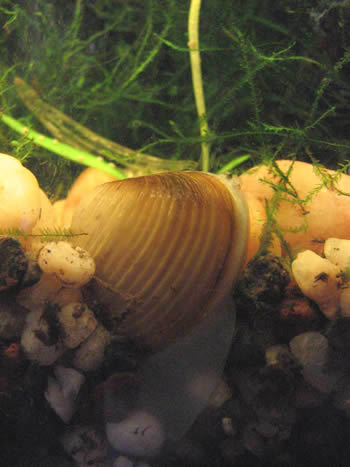Golden Freshwater Clam
By: jbeining75
Golden Clam - Picture by Karbomb
Species name: Corbicula fluminea
Common name: Golden Clam, Golden Freshwater Clam, Asian Clam, Asiatic Clam, Good Luck Clam, Prosperity Clam
Family: Corbiculidae
Order: Veneroida
Class: Bivalvia
Maximum size: 2 inches (larger than a nickel but small than a half dollar)
Coloration: Light gold-brown with darker brown streaks throughout. The shell if scratched and peeled will show a white flaky coloration underneath. The inside of the shells often show a slight purple tint to them.
Environment: Freshwater
Origin: Naturally occurring in Eastern and Southeastern Asia. Found in Japan, Korea, China, Philippines, Taiwan, Thailand, and even in parts of Eastern Russia. They are an invasive species and have been introduced in Northern America and Europe.
Temperament: Peaceful
Company: Most fish can be kept with the clam as it is not carnivorous and will not cause harm to the fish. It is best not kept with any large, aggressive, or carnivorous fish. Crayfish, crabs, most loaches, and pufferfish will also attack the clam.
Water parameters: Temperature can vary 64-82 but keeping towards higher temperatures will increase life span, pH 7.2-8.4. Stable levels of ammonia and nitrite at zero are best. Since they are filter feeders and eat particles from the water they are not tolerant to any ammonia or nitrite as almost all invertebrates are not.
Aquarium setup: A nice and soft sandy bottom or very small gravel substrate is recommended as they are partial burrowers. They can be kept in almost any type of setting with or without plants. For general aquarium settings allow the clam around an 6-8 inch square for themselves.
Feeding: You don’t have to actually feed this clam anything. This clam is a microfilter feeder and will filter out debris in the water. Crushed clam pellets or shrimp pellets can be used. They will filter particles out of the water though so they pellets would need to be crushed finely.
Breeding: These clams are self fertilizers and will produce eggs and then sperm. Generally they can release up to 2,000 juvenile clams per day ranging up to around 100,000 over a lifetime of breeding. Juveniles generally allow anywhere from one to four years to reach maturity and became fertile at maturity. It has been said that the juveniles when released may affect the gills of fish in the tank causing problems. This is debatable between keepers.
